Table of Contents

9. Soil
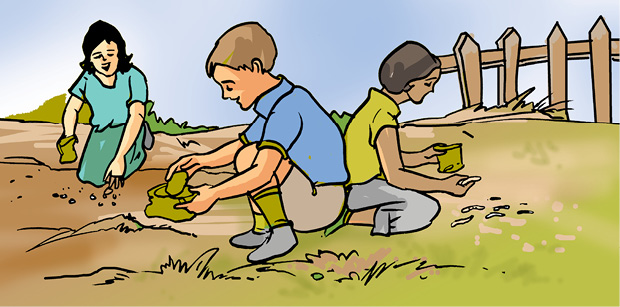
Fig. 9.1 Children playing with soil
9.1 Soil teeming with life
One day during the rainy season Paheli and Boojho observed an earthworm coming out of the soil. Paheli wondered whether there were other organisms also in the soil. Let us find out.
Activity 9.1
Collect some soil samples and observe them carefully. You can use a hand lens. Examine each sample carefully and fill in Table 9.1.
- Discuss your observations with your friends.
- Are the soil samples collected by your friends similar to the ones collected by you?
Boojho and Paheli have used soil in many ways. They enjoy playing with it. It is a great fun indeed.
Make a list of the uses of soil.

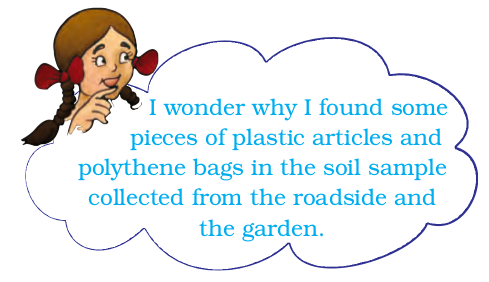
Polythene bags and plastics pollute the soil. They also kill the organisms living in the soil. That is why there is a demand to ban the polythene bags and plastics. Other substances which pollute the soil are a number of waste products, chemicals and pesticides. Waste products and chemicals should be treated before they are released into the soil. The use of pesticides should be minimised. |
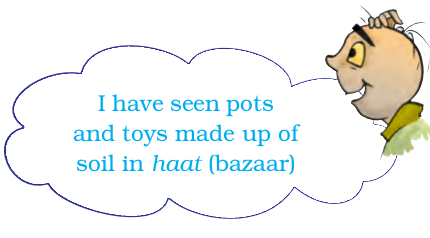
9.2 Soil Profile
Soil is composed of distinct layers. Perform the following activity to find out how these layers are arranged.
Activity 9.2
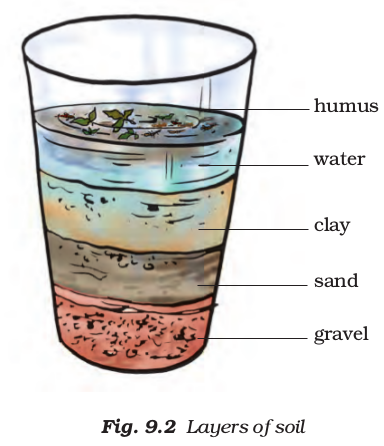
- Do you see layers of particles of different sizes in the glass tumbler?
- Draw a diagram showing these layers.
- Are there some dead rotting leaves or animal remains floating on water?
The rotting dead matter in the soil is called humus.
You probably know that the soil is formed by the breaking down of rocks by the action of wind, water and climate. This process is called weathering. The nature of any soil depends upon the rocks from which it has been formed and the type of vegetation that grows in it.
We usually see the top surface of the soil, not the layers below it. If we look at the sides of a recently dug ditch, we can see the inner layers of the soil, too. Such a view enables us to observe the soil profile at that place. Soil profile can also be seen while digging a well or laying the foundation of a building. It can also be seen at the sides of a road on a hill or at a steep river bank.
The uppermost horizon is generally dark in colour as it is rich in humus and minerals. The humus makes the soil fertile and provides nutrients to growing plants. This layer is generally soft, porous and can retain more water. It is called the topsoil or the A-horizon. This provides shelter for many living organisms such as worms, rodents, moles and beetles. The roots of small plants are embedded entirely in the topsoil.

The third layer is the C-horizon, which is made up of small lumps of rocks with cracks and crevices. Below this layer is the bedrock, which is hard and difficult to dig with a spade.
9.3 Soil types
As you know, weathering of rocks produces small particles of various materials. These include sand and clay. The relative amount of sand and clay depends upon the rock from which the particles were formed, that is the parent rock. The mixture of rock particles and humus is called the soil. Living organisms, such as bacteria, plant roots and earthworm are also important parts of any soil.
The soil is classified on the basis of the proportion of particles of various sizes. If soil contains greater proportion of big particles it is called sandy soil. If the proportion of fine particles is relatively higher, then it is called clayey soil. If the amount of large and fine particles is about the same, then the soil is called loamy. Thus, the soil can be classified as sandy, clayey and loamy.
The size of the particles in a soil has an influence on its properties. Sand particles are quite large. They cannot fit close together, so there are large spaces between them. These spaces are filled with air. We say that the sand is well aerated. Water can drain quickly through the spaces between the sand particles. So, sandy soils tend to be light, well aerated and rather dry. Clay particles, being much smaller, pack tightly together, leaving little space for air. Unlike sandy soil, water can be held in the tiny gaps between the particles of clay. So clayey soils have less air. But they are heavy as they hold more water than the sandy soils.
The best topsoil for growing plants is loam. Loamy soil is a mixture of sand, clay and another type of soil particle known as silt. Silt occurs as a deposit in riverbeds. The size of the silt particles is between those of sand and clay. The loamy soil also has humus in it. It has the right water holding capacity for the growth of plants.
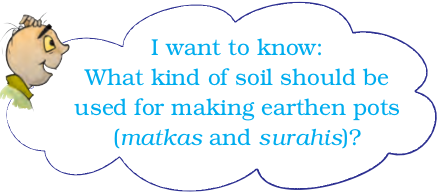
Activity 9.3
Collect samples of clayey, loamy and sandy soils. Take a fistful of soil from one of the samples. Remove any pebbles, rocks or grass blades from it. Now, add water drop-by-drop and knead the soil [Fig. 9.4 (a)]. Add just enough water so that a ball [Fig. 9.4 (b)] can be made from it, but at the same time it should not be sticky. Try to make a ball
[Fig. 9.4 (c)] from this soil. On a flat surface, roll this ball into a cylinder [Fig. 9.4 (d)]. Try to make a ring from this cylinder [Fig. 9.4 (e)]. Repeat this activity with other samples also. Does the extent to which a soil can be shaped indicate its type?
Can you suggest which type of soil would be the best for making pots, toys and statues?
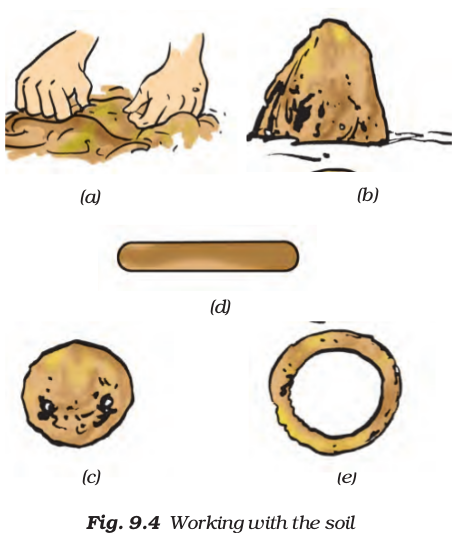
9.4 Properties of Soil
You have listed some uses of soil. Let us perform some activities to find the characteristics of the soil.
Percolation rate of water in soil
Boojho and Paheli marked two different squares of 50 cm × 50 cm each, one on the floor of their house and the other on the kutcha (unpaved) road. They filled two bottles of the same size with water. They emptied the water from the bottles, one each, at the same time in the two squares. They observed that the water on the floor flowed down and was not absorbed. On the kutcha road, on the other hand, the water was absorbed.

Activity 9.4
For this activity divide yourself into three teams. Name the teams A, B and C. You will be finding out how fast the water passes down the soil. You will need a hollow cylinder or a pipe. Ensure that each team uses pipes of the same diameter. Some suggestions for obtaining such a pipe are given below:
1. If possible, get a small tin can and cut off its bottom.
2. If PVC pipe (approx. diameter 5 cm) is available, cut it into 20 cm long pieces and use them.
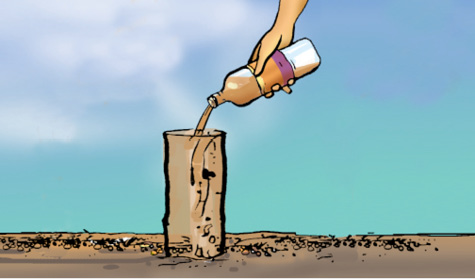
Fig. 9.5 Measuring rate of percolation
At the place where you collect the soil, place the pipe about 2 cm deep in the ground. Pour 200 mL water in the pipe slowly. For measuring 200 mL water you can use any empty 200 mL bottle. Note the time when you start pouring water. When all the water has percolated leaving the pipe empty, note the time again. Be careful not to let the water spill over or run down on the outside of the pipe while pouring. Calculate the rate of percolation by using the following formula:

For example, suppose that for a certain sample, it took 20 minutes for 200 mL to percolate. So,

Calculate the rate of percolation in your soil sample. Compare your findings with others and arrange the soil samples in the increasing order of the rate of percolation.
9.5 Moisture in Soil
Have you ever passed through a farmland during a hot summer day? Perhaps you noticed that the air above the land is shimmering. Why is it so? Try out this activity and find the answer.
Activity 9.5
Take a boiling tube. Put two spoonfulls of a soil sample in it. Heat it on a flame
(Fig. 9.6) and observe it. Let us find out what happens upon heating.
Do you see water drops any where? If yes, where did you find them?
On a hot summer day, the vapour coming out of the soil reflect the sunlight and the air above the soil seems to shimmer.
After heating the soil, take it out of the tube. Compare it with the soil which has not been heated. Note the difference between the two.
9.6 Absorption of Water by Soil
Do all the soils absorb water to the same extent? Let us find out.
Activity 9.6
Take a plastic funnel. Take a filter paper (or a piece of newspaper sheet), fold and place it as shown in the figure (Fig. 9.7). Weigh 50g of dry, powdered soil and pour it into the funnel. Measure a certain amount of water in a measuring cylinder and pour it drop by drop on the soil. You can use a dropper for this purpose. Do not let all the water fall at one spot.
Pour water all over the soil. Keep pouring water till it starts dripping. Subtract the amount of water left in the measuring cylinder from the amount you started with. This is the amount of water retained by the soil. Record your results in your notebook in the following manner:
Weight of soil = 50g
Initial volume of water in the measuring cylinder = U mL
Final volume of water in the measuring cylinder = V mL
Volume of water absorbed by the soil = (U – V) mL
Weight of water absorbed by the soil = (U – V) g
(1 mL of water has weight equal to 1 g)
percentage of water absorbed
= 
Repeat this activity with different soil samples. Would you get the same results for all the samples? Discuss the results with your friends and answer the following question:
- Which soil would have the highest percolation rate?
- Which soil would have the lowest percolation rate?
- Boojho heard from his neighbourer that 8–10 days after the rain, the level of water in a pond or well rises. Which type of soil will allow water to reach a well faster and in greater amount?
- Which type of soil retains the highest amount of water and which retains the least?
- Can you suggest any method to let more rain water percolate and reach the water underground?
9.7 Soil and Crops
Different types of soils are found in different parts of India. In some parts there is clayey soil, in some parts there is loamy soil while in some other parts there is sandy soil.
Clayey and loamy soils are both suitable for growing cereals like wheat, and gram. Such soils are good at retaining water. For paddy, soils rich in clay and organic matter and
having a good capacity to retain water are ideal. For lentils (masoor) and other pulses, loamy soils, which drain water easily, are required. For cotton, sandy-loam or loam, which drain water easily and can hold plenty of air, are more suitable.
Crops such as wheat are grown in the fine clayey soils, because they are rich in humus and are very fertile. Find from your teachers, parents and farmers the type of soils and crops grown in your area. Enter the data in the following Table 9.2:
Which kind of soil would be most suitable for planting rice? Soil with a higher or lower rate of percolation?
Gram (g) and kilogram (kg) are actually units of mass. A mass of 1 gram weighs 1 gram weight, and a mass of 1 kilogram weighs 1 kilogram weight. However, in daily life, and in commerce and industry, the distinction between gram and gram weight is generally omitted. |
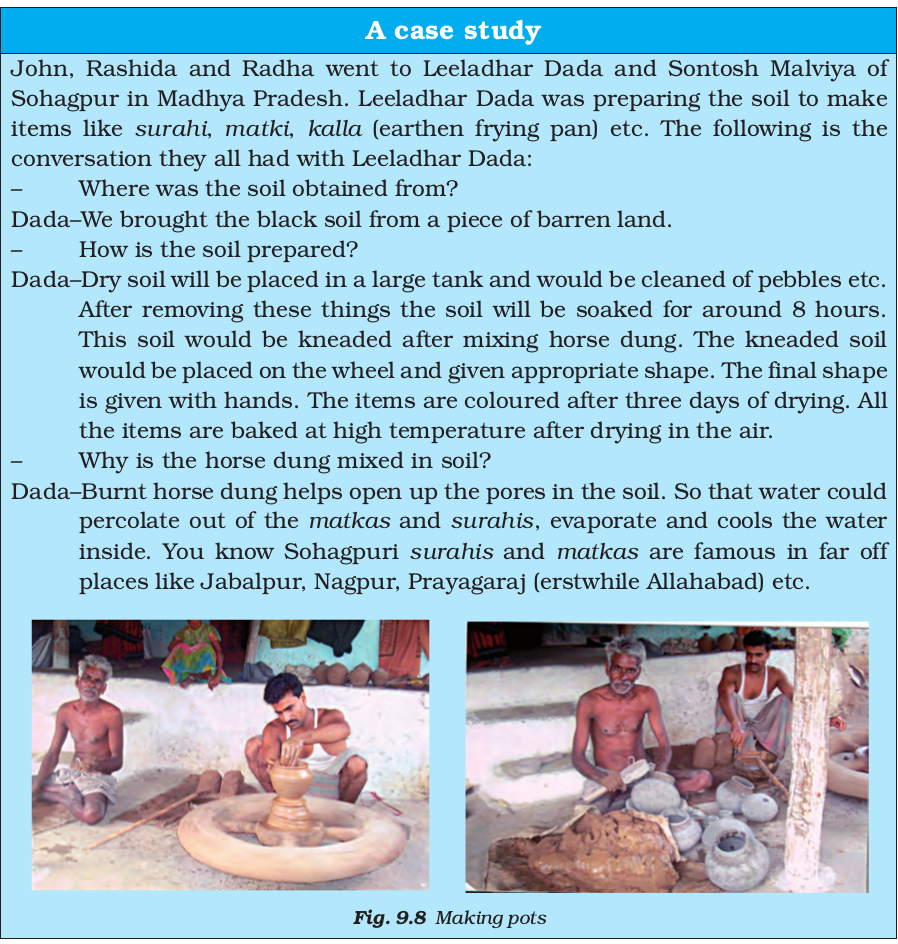
| Keywords | ||
| Clayey | Moisture | Humus |
| Sandy | Loamy | Water retention |
| Percolation |
| Soil erosion |
The removal of land surface by water, wind or ice is known as erosion. Plant roots firmly bind the soil. In the absence of plants, soil becomes loose. So it can be moved by wind and flowing water. Erosion of soil is more severe in areas of little or no surface vegetation, such as desert or bare lands. So, cutting of trees and deforestation should be prevented and effort should be made to increase the green areas. |
| What you have learnt |
|
Exercises
Tick the most suitable answer in questions 1 and 2.
1. In addition to the rock particles, the soil contains
(i) air and water
(ii) water and plants
(iii) minerals, organic matter, air and water
(iv) water, air and plants
2. The water holding capacity is the highest in
(i) sandy soil
(ii) clayey soil
(iii) loamy soil
(iv) mixture of sand and loam
3. Match the items in Column I with those in Column II:
Column I Column II
(i) A home for living organisms (a) Large particles
(iii) Sandy soil (c) Dark in colour
(iv) Middle layer of the soil (d) Small particles and packed tight
(v) Clayey soil (e) Lesser amount of humus
4. Explain how soil is formed.
5. How is clayey soil useful for crops?
6. List the differences between clayey soil and sandy soil.
7. Sketch the cross section of soil and label the various layers.
8. Razia conducted an experiment in the field related to the rate of percolation. She observed that it took 40 min for 200 mL of water to percolate through the soil sample. Calculate the rate of percolation.
9. Explain how soil pollution and soil erosion could be prevented.
10. Solve the following crossword puzzle with the clues given:
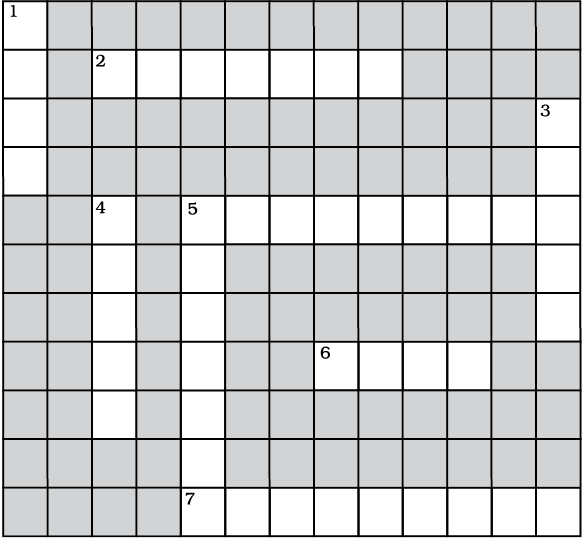
Across
2. Plantation prevents it.
5. Use should be banned to avoid soil pollution.
6. Type of soil used for making pottery.
7. Living organism in the soil.
Down
1. In desert soil erosion occurs through.
3. Clay and loam are suitable for cereals like.
4. This type of soil can hold very little water.
5. Collective name for layers of soil.
Extended Learning — Activities and Projects
1. Boojho would like to know the difference between raw and baked soil? Investigate how the soil from which matkas are made is different from the soil used to make statues.
2. Paheli is worried. She could see a brick kiln from her house. Bricks were being made there. There was so much smoke coming out of the kiln. She was told that the best quality of clay is required for making pottery, statues and bricks. She has seen truck loads of bricks being taken away for construction of buildings. At this rate, she fears, no soil will be left. Are her fears justified? Discuss this problem with your parents, teachers and other experts of your area and prepare a report.
3. Try to find out the moisture content of a soil sample. One method is given here.
Activity: Take 100g soil. (Take help from any shopkeepers to weigh the soil.) Place it on a newspaper in the sun and allow it to dry for two hours. This activity is best done in the afternoon. Take care that the soil does not spill outside the newspaper. After drying it, weigh the soil again. The difference in the weight of the soil before and after drying gives you the amount of moisture contained in 100 g of soil. This is called the percentage moisture content.
Suppose your sample of soil loses 10 g on drying. Then

| Did you know? |
Rivers of north India, which flow from Himalayas, bring a variety of materials including silt, clay, sand and gravel. They deposit their materials called alluvial soil, in the planes of north India. This soil is very fertile and supports nearby half the population of India. |